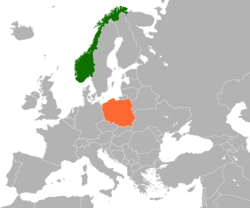Norway–Poland relations
 | |
Norway |
Poland |
|---|---|
Norway–Poland relations refers to the diplomatic relations between the Kingdom of Norway and the Republic of Poland. Both nations enjoy friendly relations, the importance of which centers on mutual historical relations and the fact that more than 100,000 Polish citizens live in Norway on a permanent basis, Poles make up 2.10% of the Norwegian population.[1] Both nations are members of the Council of Europe, Council of the Baltic Sea States, NATO, OECD, OSCE and the United Nations.
History[]
The first contact between Norway and Poland took place in the Middle Ages with Vikings (Norsemen) from Scandinavia sailing up the Vistula river in Poland.[2] The Vikings also founded and settled in Jomsborg in Pomerania and became known as Jomsvikings. Official contact between both nations began in the 10th century when Polish Princess Świętosława (daughter of Mieszko I of Poland) married King Sweyn Forkbeard of Denmark and Norway.[3] From their union, their son Cnut the Great would continue to rule Norway and the North Sea Empire. During the Hanseatic League, trade and cultural contacts developed between Polish cities on the Baltic Sea, mainly Gdańsk; and Bergen in Norway, where Polish ships reached with grain.[3]
In the 17th century, during the Swedish Deluge, Polish troops led by Stefan Czarniecki fought together with soldiers from Denmark–Norway against the Swedish invasion in Poland and during the Dano-Swedish War.[3] By the late 18th century, the third and final partition of Poland had occurred and Poland lost its independence for the next 123 years.

In 1918, after World War I, Poland regained its independence, and both nations established diplomatic relations in 1919.[3] However, political and governmental contacts were few in the interwar period, and economic cooperation and trade remained low. In 1931 Poland signed the Svalbard Treaty, which recognizes the sovereignty of Norway over the archipelago of Svalbard in the Arctic Ocean, and grants signatories equal rights to engage in commercial activities and scientific research on the archipelago.[4]
During World War II, both countries were invaded by Germany. The Polish Independent Highland Brigade fought for Norway in the Battles of Narvik against German soldiers.[5] During the war, both countries maintained close contacts as both had governments-in-exile based in London. Approximately 20,000 Poles were taken by the Germans from occupied Poland for forced labor in Norway, while some Norwegian prisoners of war were sent to German POW camps operated in occupied Poland (most notably Oflag XXI-C). After liberation, for some of them Norway became their second homeland.[6] Shortly after the end of World War II, Poland and Norway resumed diplomatic relations in 1945. In 1974, Norway's Prime Minister Trygve Bratteli paid an official visit to Poland.[3]
During the Polish Solidarity movement; the Polish Trade Unions received support from Poles living in Norway, political emigrants, Norwegian politicians and trade unionists. The official visits of King Harald V of Norway to Poland in 1993 and the President of Poland, Lech Wałęsa, to Norway in March 1995; were an expression of the will of both countries to give their mutual relations the highest rank.[7]
Since Poland's accession to NATO in March 1999, Polish-Norwegian relations have become allied and bilateral political and military cooperation have strengthened between both nations.[8] In 2012, King Harald V of Norway paid a second visit to Poland[9] and in 2016, Polish President Andrzej Duda paid a state visit to Norway.[1]
Poland is one of Norway's ten main trading partners. In 2019, Poland was the seventh largest source of imports and the tenth largest export destination for Norway.[10]
Several Polish polar stations are located in the Norwegian archipelago of Svalbard.
Bilateral agreements[]
Both nations have signed a few agreements such a trade and shipping agreement (1926); conciliation and arbitration treaty (1929); tariff arrangement (1935); customs agreement (1937); trade and payment agreement (1946) and a trade agreement (1964).[6] With Norway being a member of the European Free Trade Association and Poland being a member of the European Union; most bilateral relations between both nations are conducted through those two organizations.
Resident diplomatic missions[]

Building hosting the Embassy of Norway in Warsaw

Embassy of Poland in Oslo
See also[]
- Embassy of Poland in Oslo
- Baltic Pipe
- Poles in Norway
- Polish Independent Highland Brigade
- Norway–EU relations
References[]
- ^ a b State Visit from Poland
- ^ Slavs competed with the Vikings on these boats
- ^ a b c d e Stosunki Polsko-Norweskie (in Polish)
- ^ Oświadczenie Rządowe z dnia 3 września 1931 r. w sprawie przystąpienia Polski do traktatu dotyczącego Spitsbergu, podpisanego w Paryżu dnia 9 lutego 1920 r., Dz. U. z 1931 r. Nr 97, poz. 747
- ^ Polish Independent Highland Brigade Sailing to Narvik
- ^ a b Relations between Poland and Norway (in Polish)
- ^ Lech Wałęsa in Norway
- ^ Polish-Norwegian cooperation
- ^ Norwegian Royal couple visits Krakow
- ^ "Norway trade balance, exports and imports by country and region 2019". World Integrated Trade Solution. Retrieved 25 December 2021.
- ^ Embassy of Norway in Warsaw
- ^ Embassy of Poland in Oslo
- Norway–Poland relations
- Bilateral relations of Norway
- Bilateral relations of Poland



